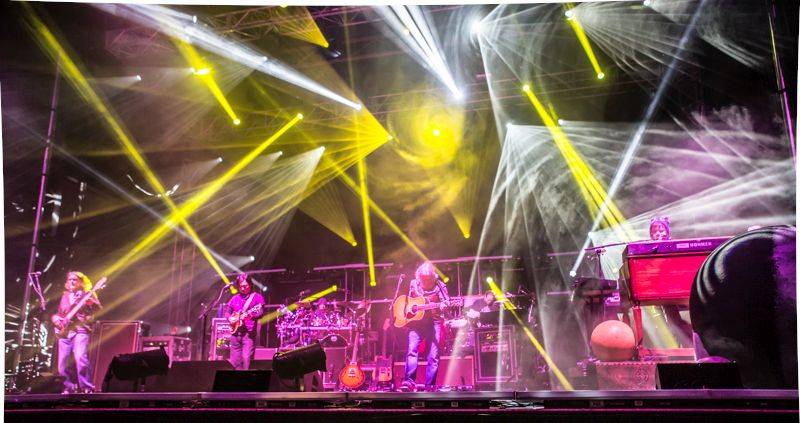The trouble with weather forecasting is that it’s right too often for us to ignore it and wrong too often for us to rely on it. — Patrick Young
If I had not been so excited about getting to the first annual Phases of the Moon Festival, I would have paused to consider the impact days of heavy rain on open fields would have on an outdoor, camping festival.
Over the weekend, we heard stories of folks waiting in line for 12 hours, only to be turned away from the entrance at around 2 a.m., far from home and with nowhere to go. Some made their way to designated waiting areas; some of the luckier ones were able to find hotel rooms nearby. Two sisters told me that they came down from Chicago for the festival, only to be turned away early Friday morning. The only hotel room available was the honeymoon suite at a hotel near Danville, which they gladly accepted.
Having attended many festivals over many years, I know this to be a fact: no amount of preparation can compensate for torrential rains before or during an outdoor festival. By comparison, the first Phases of the Moon counts as bad, but not worst.
Upon entrance to the festival, you became aware of original art displays by noted artists, but it wasn’t until the sun went down that they could be fully appreciated. Lighting and motion, creative material and artistic designs made for an enchanting walk through the festival grounds.
There were four stages at the festival: the New Moon, Full Moon, Harvest Moon, and Town Square, with the New and Full Moon comprising the two main stages, with the Harvest and Town Square stages providing smaller venue spaces. Thursday evening was cold and gray. Soggy turf and mud mixed with the smell of newly laid mulch put down to absorb the moisture, but it didn’t dampen our spirits. The night brightened considerably with the New Orleans jazz funk sounds of Galactic on the New Moon Stage, with cameos by Ivan Neville on the Hammond B3 organ, and Maggie Koerner on vocals. With their big funk bass, driving rhythm section and big horn section, the band rolled through their set, punctuated by outstanding covers of “Rock Steady”, and “Shake that Money Maker”.
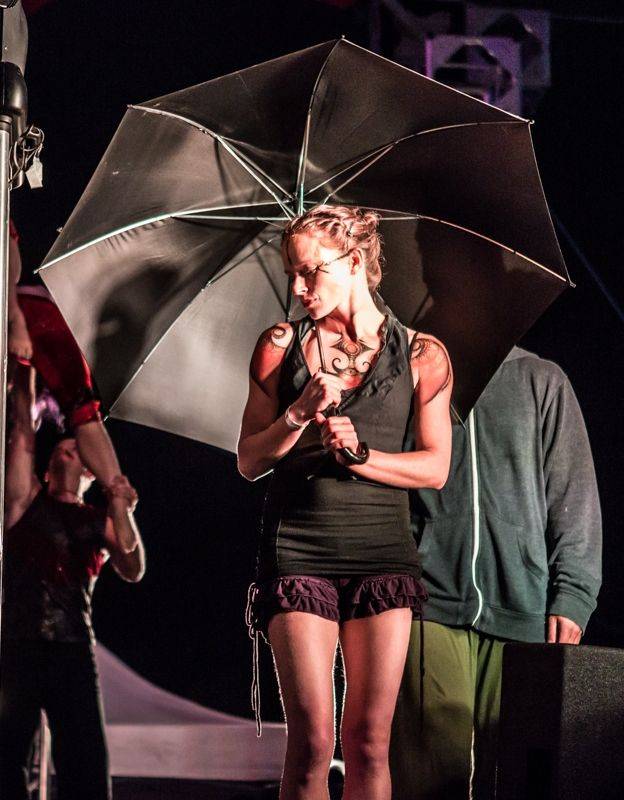
The festival presenters credited the Further Festival as one of their influences for producing Phases of the Moon. They created a “jam band“ event — The String Cheese Incident and Widespread Panic were the Full Moon stage anchors of that creation. The combination of the spectacular light show and seasoned musicianship set the scene for Thursday and Friday’s performances by The String Cheese Incident, celebrating 20 years fan appreciation, and 20 minute jam sets. The band is not without their true believers and if you can’t have fun at a String Cheese show, you’re probably adverse to fun.
Widespread Panic, the other purveyor of extended rock jams, shook the stage Saturday and Sunday nights. Twenty-six years after the release of their first album, Panic still gets it right with their southern-tinged rock ‘n roll, and southern laid back style. Their sets were made even better by the earlier break in the weather, making the night cool and clear.
Friday at noon, the festival traveled once again, to New Orleans for Dumpstaphunk, Ivan Neville’s funk quintet. The son of Aaron Neville, Ivan acquired his funk roots in the Neville Brothers band. Known for his work on the Hammond B3 and the clavinet, Neville is also the band’s lead vocalist. He sends out lyrics with the same playful intensity that he pounds out chords on the B3. From my vantage point, somewhere in the middle of the mélange, everyone was on their feet dancing, cheering, celebrating, and generally enjoying a great performance.
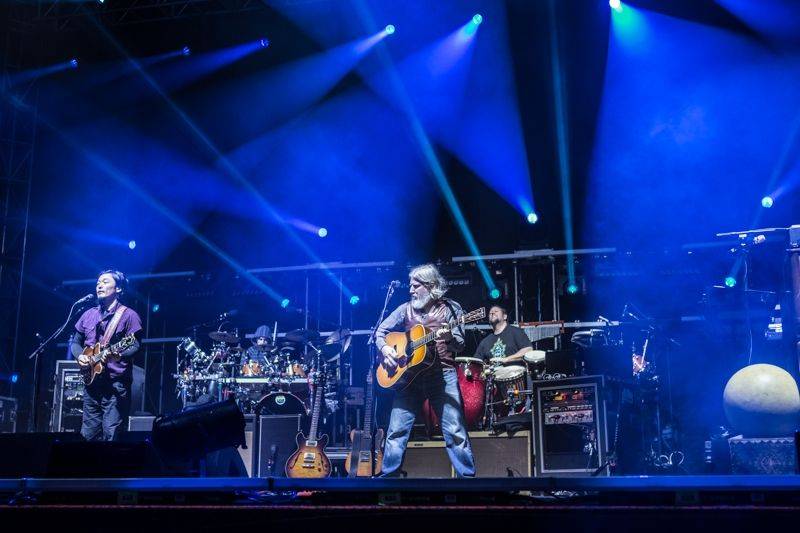
The rest of the afternoon found us comfortably situated around the Town Square stage where we caught a couple of regional bands, The Kevin Bilchik Band, and the Ernie Hendrickson Band, both playing lyric-based Americana music from the Midwest. Bilchick, a staple of the St. Louis band scene, brought his “A-game” to the festival. Rhythmic, bluesy and lyrical, the band wound through their set with spark and precision, underscored by a nice stage presence. Hendrickson, who has a residency every Monday night at the Harvest Room, in Palos Heights, IL, kept the afternoon’s music moving along nicely.
The last Town Square show of the night featured mandolin virtuoso Sam Bush and the Sam Bush Band. If there were a happier, more joyous performer playing the festival, I didn’t see him or her. With his infectious smile, and lightening quick mandolin riffs, Bush may have single-handedly pushed the clouds out of the area for the rest of the weekend. Some may know Bush from his stellar performance at ELLNORA 2013, playing the lobby stage with guitar legend Del McCoury. Some may remember him from his time with the innovative band, New Grass Revival, along with Bela Fleck. Some may have caught their first glimpse of Sam Bush at Phases of the Moon, but all should agree, the man lights up a stage. With a set list that includes songs by the Beatles, Bob Marley, riffs from Black Sabbath, and a couple rounds sounding like they were being played by an Irish band, Bush closed out the show playing violin with an extraordinary version of the Jean Luc Ponty’s song “New Country” much to the joy of many music lovers.
Saturday morning found the festival grounds filled up nicely with relieved campers whose stories of finally gaining entrance began circulating. It also found me ready to explore the visual and performance art, now that the ground was a little drier. Many of the acrobatic performers used the Harvest Moon stage, which was fitted with climbing ropes and other props. These performers need to be at the top of their game when situated high above the ground without a harness, and they were. In addition to the array of hula-hoopers, stilt walkers, fire jugglers, giant puppetry, and creative festival garb, Saturday was an explosion of movement and color. The visual art, best viewed at night, was a collection of large, and beautiful sculptures of light and shape, painstakingly constructed on the festival grounds. Trees and surfaces were lit by lamps of all sizes and colors, throwing off striking light art images. Kudos all around to the lighting director, and all of the non-musical performers. Their presence at Phases was welcome, indeed.
By Saturday afternoon, the bright sun and warm weather were drying out the grounds nicely. Several small, front end loaders spent the day laying mulch to the areas that still were too muddy for much foot traffic. The sight of a column of these loaders, each carrying a steaming, smelly load of mulch to their next destination resembled a construction site more than a festival area, but it was required to maintain the grounds and make them accessible.
At 1 p.m., Martin Sexton was taking the New Moon stage with just his guitar and a head full of songs. The first thing that strikes you about Martin Sexton is his voice — sweet, clear and powerful. His songs could be the basis for a new Great American Songbook, the collection of the most influential American pop songs of the 20th century, or maybe they just sound that way. Lyrics and styling also conjure up images of John Sebastian, John Denver, Neil Diamond, other performers, like Sexton, who really don’t need any other accompaniment beside their guitars. Towards the end of his set he started a song with the opening chords to the Yes’ song, “Roundabout”, which segued into “For What Its Worth” by Buffalo Springfield. This was clearly one of the best covers I have heard of that song, and Sexton played the hell out of it. He ended the set with a moving rendition of “America, the Beautiful”, fitting for the beautiful day and the beautiful place the festival had become.
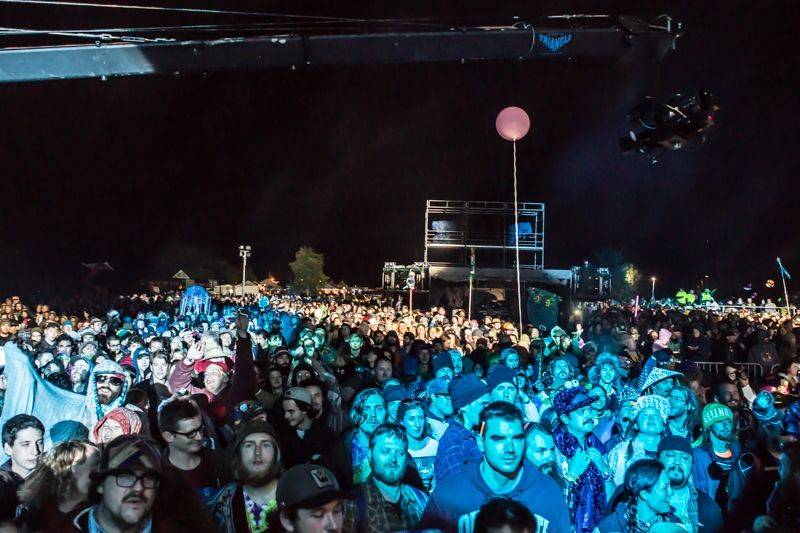
Immediately following Sexton was the Jeff Austin Band. Austin is a founding member of Yonder Mountain String Band, seemingly and thankfully, regulars at Urbana’s Canopy Club. For contemporary bluegrass there is no finer practitioner. Like Sam Bush, Austin also plays mandolin, but the comparison stays there. Growing up in the Chicago area, Austin felt the pull towards his brand of Americana music while attending a Grateful Dead show just prior to dropping out of college where he was majoring in Musical Theatre. He learned to play the mandolin by listening to ‘Not For Kids Only’, an album by Jerry Garcia and David Grisman. Jeff Austin’s set consisted of some very fine bluegrass tunes, but also something I want to call “swinggrass”, swing melodies played in bluegrass style, with bluegrass rhythms.
When you think of jam bands, a few bands come to mind: Grateful Dead, Phish, The Allman Brothers, but the list must also include Little Feat. Little Feat was started in 1969 by guitarist Lowell George, and keyboardist Bill Payne. Payne now plays with the band, Leftover Salmon, a jam band that blends bluegrass, rock, country and Zydeco with great results. At Phases the band opened with a version of the traditional, Oh Eliza, and sailed on through a medley of original work and covers, before coming around to the Little Feat classic, “Oh Atlanta”, played as originally recorded. “Dixie Chicken”, another Little Feat classic, was the next song but this one got the Salmon treatment, dissolving into a sonic blanket of psychedelia, much to the pleasure of the crowd.
Back at the Town Square stage Toubab Krewe took the stage. The band mixes folk, rock, world and West African rhythms and instrumentation to create music suitable in any rock, folk, jam or world music setting. Jump blues and jam grass, played with traditional rock and roll, and traditional African instruments was nice surprise. Their set was an outlier to the festival, but a most welcome one.
The Saturday evening show brought the Tedeschi Trucks Band to the New Moon stage. Susan Tedeschi and Derek Trucks are the husband and wife leaders of this super talented band. Derek Trucks, a former member of the Allman Brothers Band, the Grammy Award winning Derek Trucks Band, and now, the Grammy Award winning Tedeski Trucks band, has made it on to Rolling Stone’s list of greatest guitar players of all times. Susan Tedeschi, a songwriter, and guitarist in her own right, has received multiple Grammy Award nominations, having one of the most powerful voices in contemporary blues-rock. Accompanied by great rhythm and horn sections, and a superb keyboard player, the band blasted through some big band blues and southern rock riffs before Tedeschi let loose with the Loving Spoonful cover Darling Be Home Soon that sent shivers up my spine. Later, she appeared alone on stage with an acoustic guitar and her big, beautiful voice to sing Ray LaMontagne’s song, “Shelter”. Tedeschi, Trucks and company crafted a wonderful set of music.
Sunday morning came a bit too early after an eventful Saturday night. Early or not, Leon Russell’s 11:30 a.m. set on the Full Moon stage could not be missed. I knew every song Russell played, not because I crammed for this piece, but because I spent my life listening to his songs. Playing music in clubs at the age of 14 in Tulsa, Oklahoma, Russell and band mates, including J.J. Cale, were instrumental in creating a style of music referred to as the Tulsa sound, a distinctive blend of rockabilly, rock and roll, country, and blues. I first heard Leon Russell play exquisite keyboards on the 1970 release of English rocker, Joe Cocker’s album, Mad Dogs and Englishmen, which Russell co-produced. In collaboration with Elton John, who says Russell was his musical inspiration when starting out, Russell earned a Grammy Awards nomination in 2010 for their album, The Union. Sporting a white cowboy hat over his long white hair, Russell’s set was void of superfluous chatter. He was there to play. With a bass player, a drummer and a mandolin player, Russell played the songs he has always played, “Rolling In My Sweet baby’s Arms”, “Stranger in a Strange Land”, Dylan’s, “Hard Rain Is Gonna Fall”, “Georgia On My Mind”, and then went solo for “Sweet Emily”, “Mad Dogs and Englishmen” and “Song For You”. The band came back to finish the set with a medley; Jumping Jack Flash, with a segue into the chords for “Poppa Was A Rolling Stone”, followed by the intro to the Stones, “Paint it Black” as a segue into the classic “Kansas City”. The set came to a close on a high note with Russell playing what he believes to be the very best rock and roll song ever and written by a friend of his, “Roll Over Beethoven”.
The next show on the Full Moon stage was the band, Vintage Trouble, playing soul and R&B like it needs to be played. Started in 2010 by singer Ty Taylor and Nalle Colt, Taylor sounds like Motown’s Jackie Wilson, backed up by the sound of Stax Records in Memphis in the 1950s and 60s that included studio musicians Booker T Jones, Steve Cropper and Donald “Duck” Dunn, backing up Otis Redding, Wilson Pickett, Sam & Dave, to name a few. Taylor dazzled the audience when he jumped off stage (no stairs!) and promenaded through the assemblage singing and serenading. He even managed to climb the lighting tower at the back of the concert area while still singing.
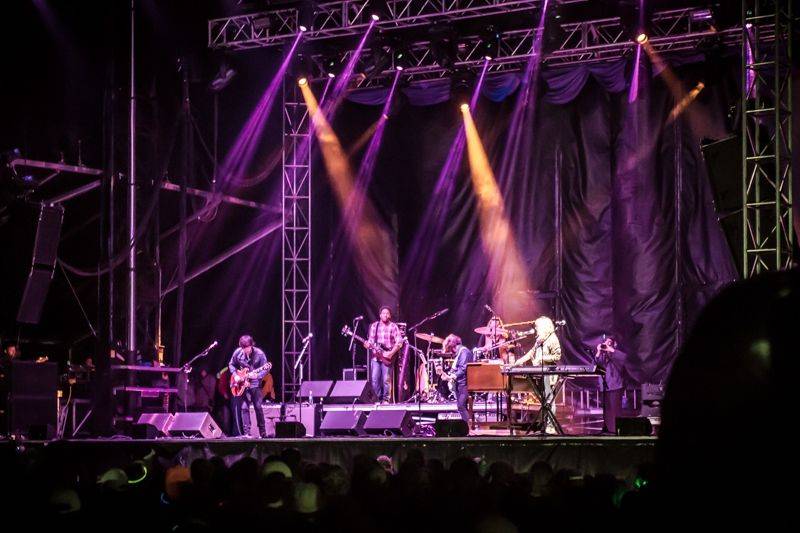
The afternoon show on the Full Moon stage was another ELLNORA veteran, Robert Randolph & the Family Band. Randolph started playing music in church, playing a music form called “sacred steel”, music leads played on a pedal steel guitar with or without a full band accompaniment. The Family Band is a band capable of glorious music in its own right, but the times Randolph played solo, even just for a long intro, or a segue between songs, were the sweetest. Randolph and his band may play church inspired riffs, but that doesn’t mean it’s church music. This music is brash and funky, even boisterous, with Randolph wailing on the high leads while the bass and guitar come in sweet and low, under the melody. Stellar performance.
Like any large festival, there are bound to be practical problems. Water, parking, information, communication are all challenges that are hard to overcome in the best of circumstances, and Phases problems were exacerbated by bad weather prior to the festival. Issues need to be addressed, changes need to be made, but problems concerning the music and art production of the festival were non-existent. Sound and lighting seemed flawless. The art displays were wonderfully arranged to make best use of the space. I would encourage the 2nd annual Phases of the Moon festival, and I would very much like to attend.
Photos courtesy of Mark Spomer.








